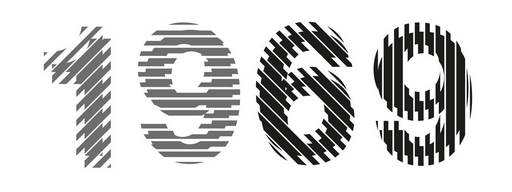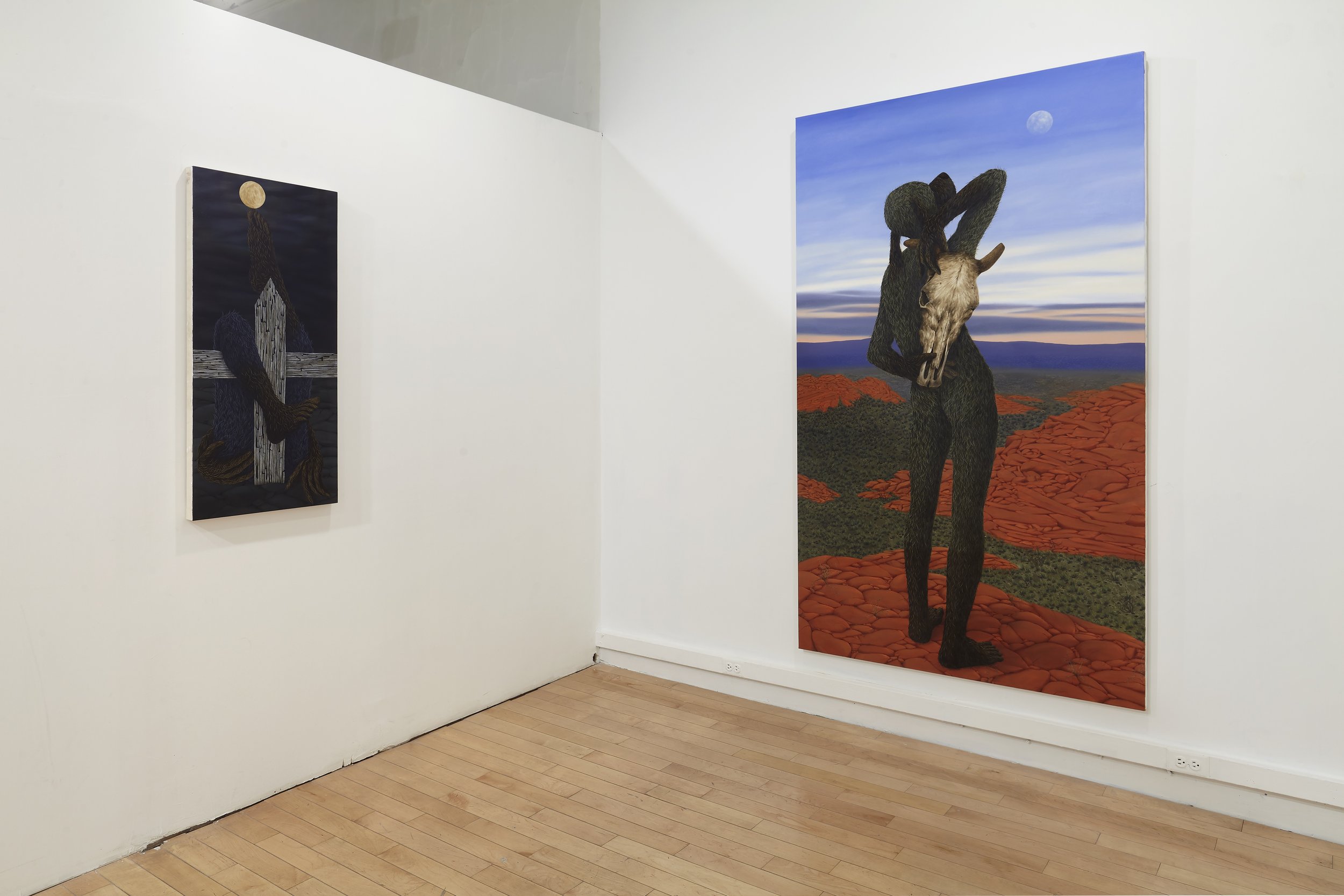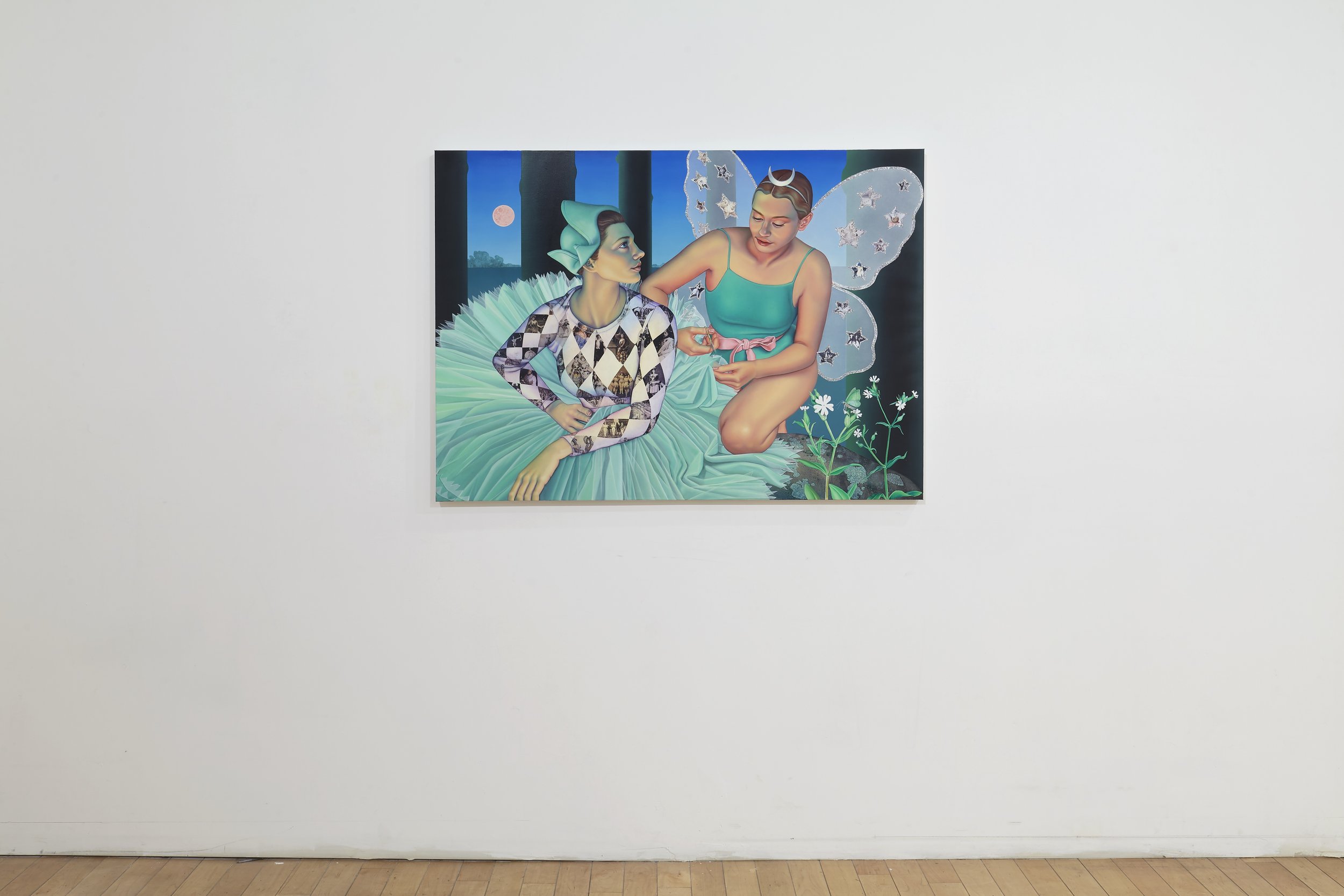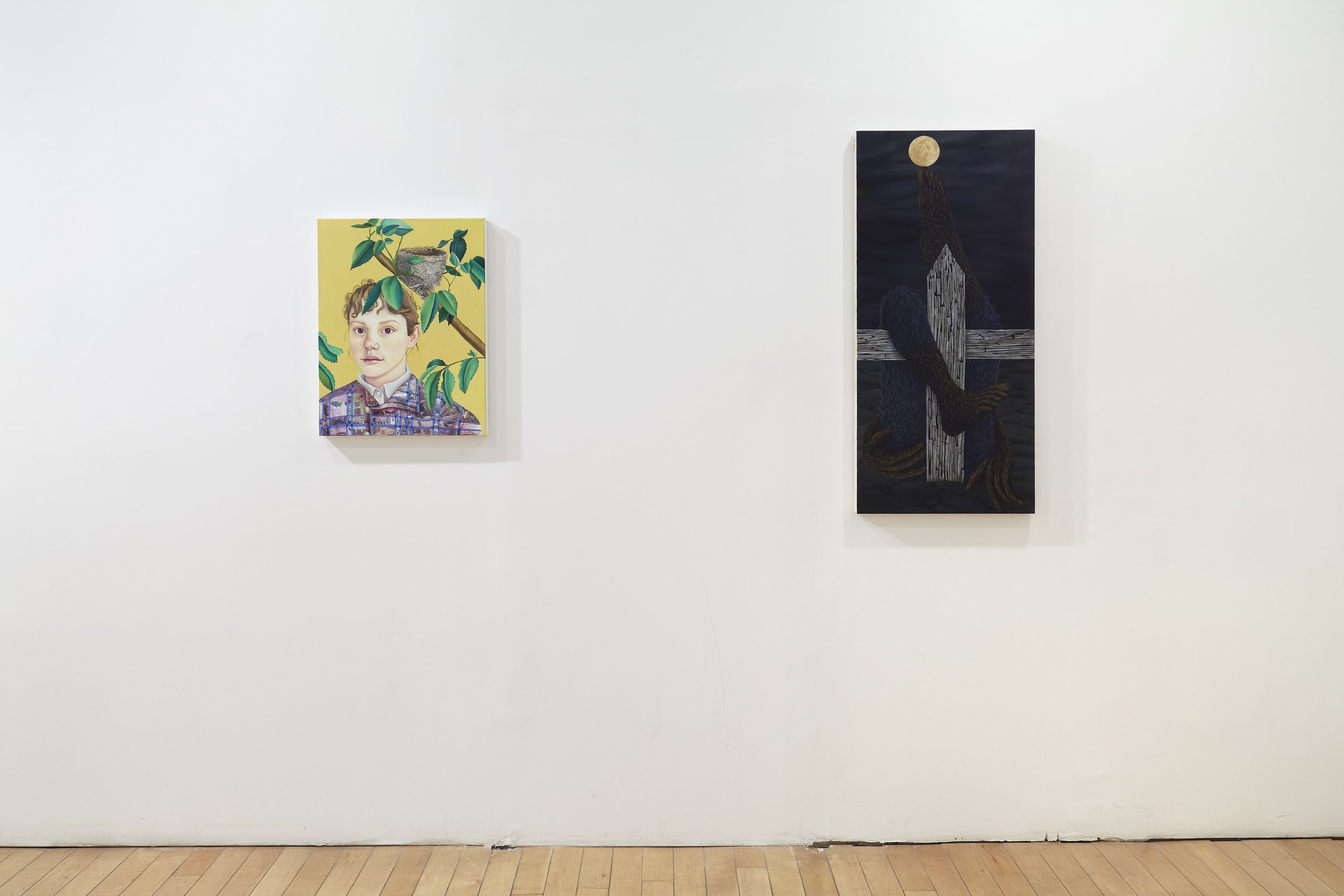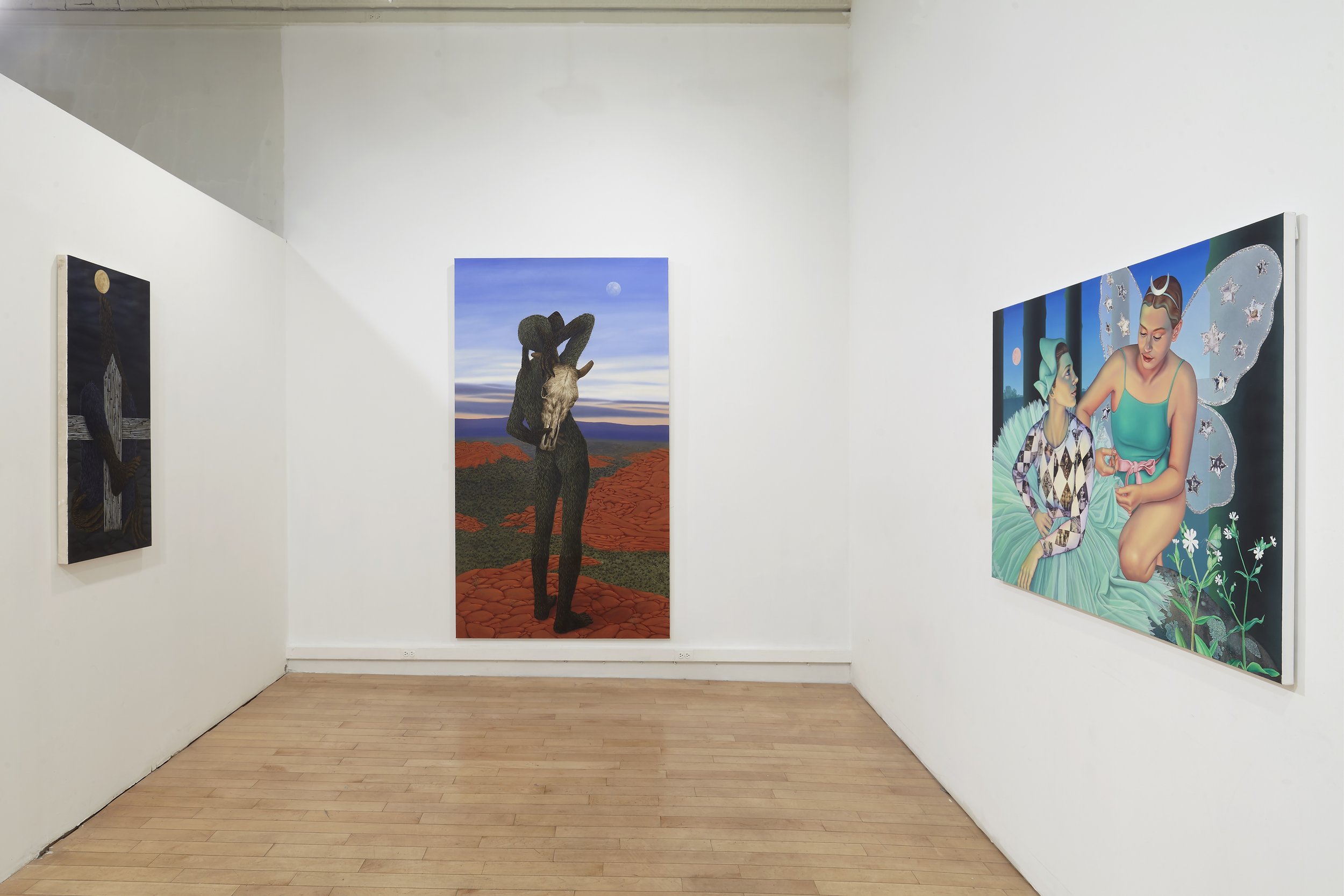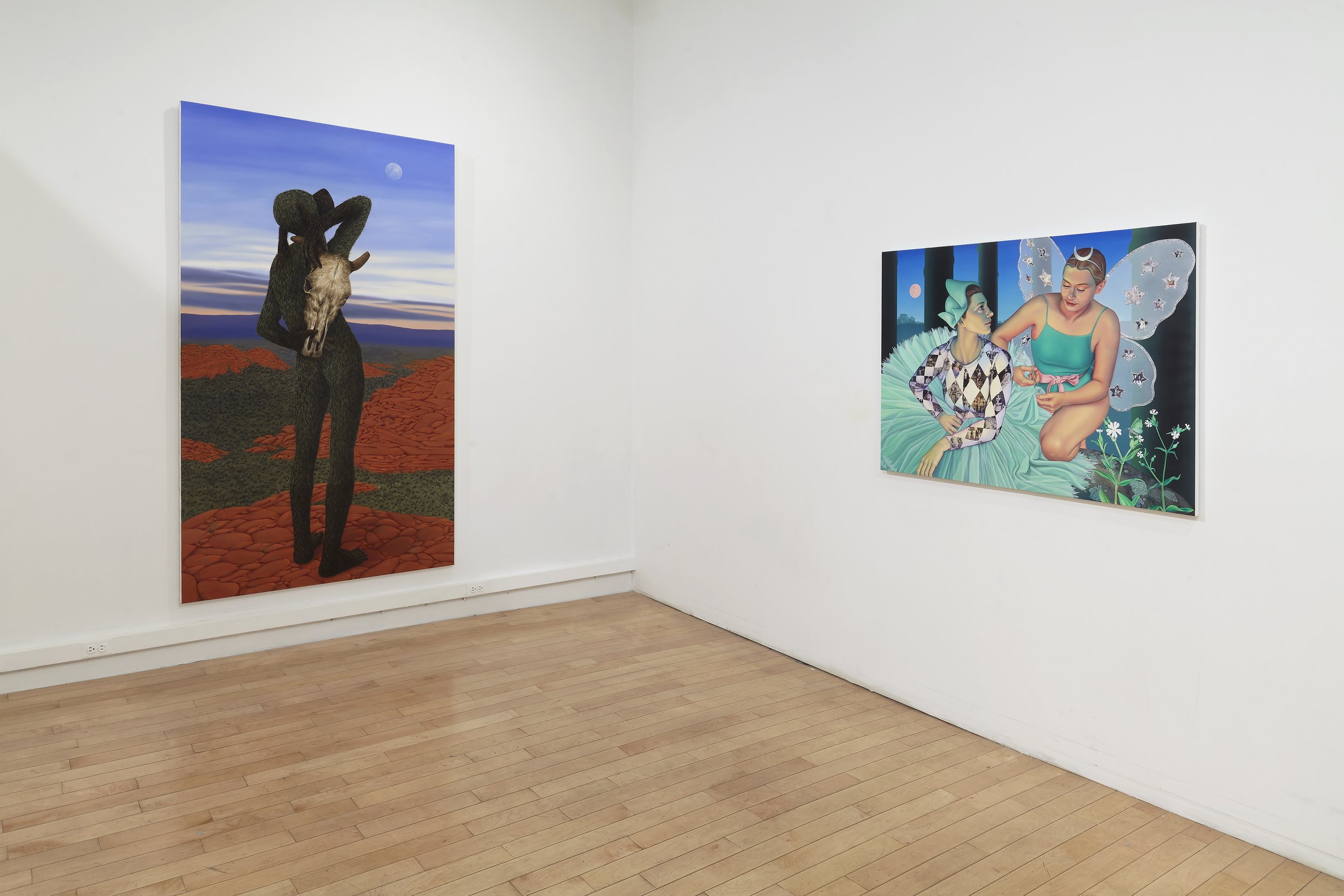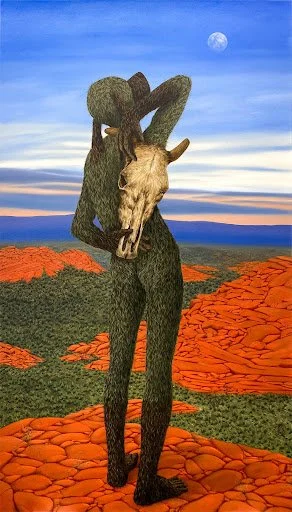Drew Dodge + Emma Steinkraus
Exhibition Dates: January 13 – February 26, 2022
Drew Dodge
Drew Dodge, Day, 2022, oil on canvas, 84h x 48w inches
Drew Dodge, Night, 2022, oil on canvas, 42h x 19w inches
1. What’s up with the anthropomorphism in your works?
When I first started painting the figure, I was searching for a body that I felt connected to, but one that I did not know. For me, the hairy dog-people that frequent my paintings are distantly familiar, and I can empathize and find a harmony between myself and them while also being comfortable as an observer. They occupy a liminal space between human and animal, and I get excited when they reveal their behavior and desires to me. I am comfortable with the ambiguity of the figures because it allows them to exist in their own space, have privacy, and experience complete freedom. I enjoy finding representations of Queerness in anthropomorphic bodies because it presents a synergy between Queerness, nature, and spirit. I am invested in sensation, so I gravitated towards painting an absorbent, bristly, hair-covered body, which I imagine to be extremely stimulating to encounter the world through. Because I am positioned at a mysterious distance, I conceptualize the figures being past, future, or inner versions of myself.
2. Which artists are most influential to your work?
For a while now, I have had an affinity for Louis Fratino’s work. Initially, I fell in love with his stylized figures that interlock, embrace, and arrange themselves in puzzling and comforting ways. However, his non-figurative paintings have been my favorite. I admire his simple, vision of Queerness and ability to paint a sink full of dishes or an organization of fish in a way that I connect to as a young gay painter. His fluent vocabulary and observant, thoughtful gaze has encouraged me to find quiet and enigmatic visions of Queerness that manifest beyond the body. Tala Madani is another painter I have been very intrigued by. Her playful yet extremely profound paintings have inspired me to be more bold and thoughtful with my compositions. My favorite part about her work is how she situates and provokes figures to engage with themselves and others in very deep, personal, and bodily ways. Last but not least, I admire Jennifer Packer, who was my first painting professor at RISD, and her ability to paint sentient atmospheres, which ground her depictions of people, spaces, and florals. Experiencing her work when I first started painting motivated me to approach my paintings with vulnerability, mystery, and honesty, which anchored my practice in ways that allowed me to curiously express myself in my work in subtle or evocative ways.
Emma Steinkraus
Emma Steinkraus, Empty Nest (for Gennie & Virginia Jones), Soft pastel, acrylic, and photo transfer on canvas, 24h x 18w inches
Emma Steinkraus, Strawberry Moon (for Amelia Jane Murray, Maude Adams, & Zinaida Serebriakova), 2022, oil on canvas, 36h x 48w inches
1. Tell us about how the process of research influences your creative decision-making.
I’m often looking for answers to two historical questions: what kinds of art have women made? And how have people interacted with and observed non-human nature? For the past couple of years, I’ve been researching women artist-naturalists, especially ones who worked before 1900. So, for example, the piece Empty Nest (for Gennie & Virginia Jones), is inspired by Genevieve Estelle Jones, who is sometimes called “the other Audubon” because she initiated the creation of an enormous illustrated nineteenth-century guide to the nests of North American birds.
She had a tragic life in some ways; she was star-crossed in love and died young. After Gennie’s death, her mother Virginia learned to draw in order to finish the project. The nest in my painting is based on one from their books.
To bring research into the paintings, I often add photo transfers of found images. I think of them as visual footnotes. In Empty Nest, the jacket is covered with transfers that relate to birds. They connect archival images from Jones’s era - like photos of the destruction of old-growth forests - to contemporary environmental catastrophes. Did you know that there are nearly 30% fewer birds in North America now than in the 1970s? Or that studies show being around more bird species makes you demonstrably happier? I think a lot of my work has a kind of one-two punch, where I try to make these really beautiful, seductive surfaces that reel you in, but then if you pay attention to the photo transfers there’s a more intellectually complicated story.
2. Which artists are most influential to your work?
There are so many! Chris Ofili, Inka Essenhigh, Nicolas Party, and Njideka Akunyili Crosby are all huge long-term influences who have shaped the ways I use color, stylize nature, and combine paintings with murals and photo transfers. Jocelyn Hobbie, TM Davy, Erin Jane Nelson, and Nikki Maloof are also forever favorites. This probably goes without saying, but I can’t imagine what figurative painting would be today without Nicole Eisenman and Kerry James Marshall. Ditto for David Hockney, who is also an inspiration for how to live; may we all spend our eighties painting en plein air and lounging with dachshunds. Truly there are so many others. And beyond contemporary art, there’s all of art history. My real dream is to be understood as continuing an artistic lineage that goes from Botticelli through Evelyn de Morgan (with a dash of Rogier van der Weyden).
For further information or to request images, members of the media may contact Amanda Barker | e: amanda@1969gallery.com | t: +1 (212) 777-2172
About 1969 Gallery
Founded in September 2016, 1969 is a contemporary art gallery, with two gallery spaces in Manhattan’s Lower East Side and Tribeca neighborhoods. Through solo / group / external exhibitions and art fair presentations, the Gallery has cultivated the careers of its six represented artists and a broader community of artists primarily devoted to painting. Our independently curated exhibitions also expand our audience by exhibiting all different forms of art from artists worldwide.
During the past five-and-a-half years, we have organized over fifty exhibitions, including four curated online exhibitions, and participated in seven art fairs and published four books and catalogs and co-published one ‘zine. (Our 2022 goal is to publish more critical writing about artists and exhibitions at 1969). Our gallery roster ncludes members of the LGBTQ and BIPOC communities, including two Latinx artists and one gender non-binary artist.
A highlight of our recent accomplishments include: a two-gallery exhibition in partnership with Albertz Benda of paintings and works on paper by Cristina BanBan; our residency program at our original LES gallery space; and placement of our artists’ works into museum and institutional collections including ICA Miami, The High Museum (Atlanta, GA), Whitney Museum of American Art (NYC) and The Columbus Museum of Contemporary Art (Ohio).
Follow 1969 Gallery on Instagram via @1969gallery.
